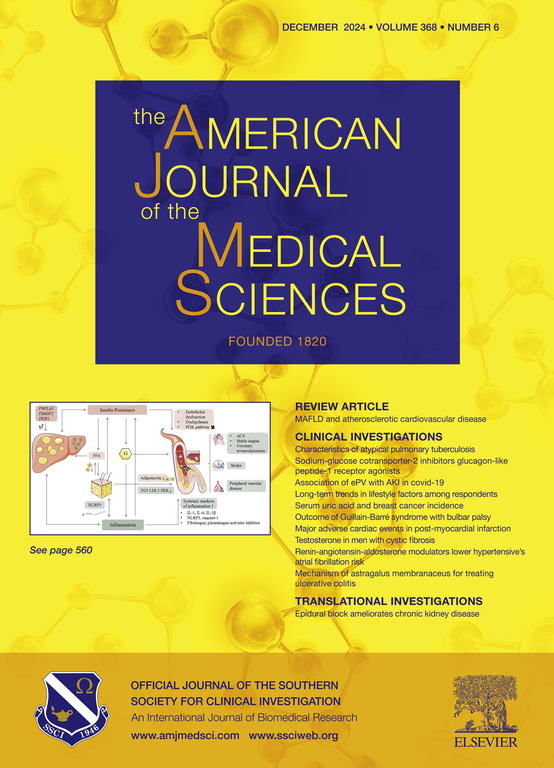HIF-1α对st段抬高型心肌梗死后左室重构的预测价值。
IF 2.3
4区 医学
Q2 MEDICINE, GENERAL & INTERNAL
引用次数: 0
摘要
背景:缺氧诱导因子-1α (HIF-1α)在包括心肌纤维化和肥厚在内的心室重构过程中发挥着重要作用,但st段抬高型心肌梗死(STEMI)后早期HIF-1α水平对左心室重构(LVR)的预测临床意义尚未完全阐明。目的:探讨HIF-1α基于超声心动图参数对STEMI后LVR的预测价值。方法:在这项前瞻性观察研究中,183例首次再灌注前st段抬高型心肌梗死(STEMI)患者在发病后12小时内收集血浆样本,并使用酶联免疫吸附试验(ELISA)检测HIF-1α水平。所有患者在基线和出院后12个月复查超声心动图。超声心动图参数从基线到12个月的变化反映心室结构和功能的变化。舒张末期容积增加≥20%定义为LVR。结果:HIF-1α水平与超声心动图参数(ΔLVEF、ΔLVEDD、ΔLVEDV)变化高度相关。在随访期间,HIF-1α浓度较高的患者LVR发生率较高,心室功能较差,无mace生存期较低。多因素分析显示,单点HIF-1α是LVR的独立预测因子(比值比[OR]: 4.813;95%CI:1.553 ~ 14.918;P = 0.006)。HIF-1α水平预测LVR的AUC为0.7905 (95% CI为0.7067 ~ 0.8744)。结论:血清HIF-1α水平可独立预测STEMI后LVR。本文章由计算机程序翻译,如有差异,请以英文原文为准。
Predictive value of HIF-1α for left ventricular remodeling following an anterior ST-segment elevation myocardial infarction
Background
Hypoxia-inducible factor-1α (HIF-1α) has an essential role in ventricular remodeling processes involving myocardial fibrosis and hypertrophy, but the clinical significance of HIF-1α levels in the early period after ST-segment elevation myocardial infarction (STEMI) for the prediction of left ventricular remodeling (LVR) has yet to be fully elucidated.
Objective
To investigate the predictive value of HIF-1α for LVR after STEMI based on the echocardiographic parameters.
Methods
In this prospective observational study, plasma samples were collected within 12 hours of onset from 183 patients with a first reperfused anterior ST-segment elevation myocardial infarction (STEMI), and HIF-1α levels were measured using enzyme-linked immunosorbent assay (ELISA). At baseline and 12 months after discharge, all patients underwent repeat echocardiography. The changes of echocardiography parameters from baseline to 12 months were used to reflect the changes of ventricular structure and function. An increase in end-diastolic volume of ≥20 % was defined as LVR.
Results
The levels of HIF-1α were highly correlated with the changes of echocardiography parameters (ΔLVEF, ΔLVEDD, as well as ΔLVEDV). During the follow-up period, patients with higher HIF-1α concentrations had higher incidence of LVR, poorer ventricular function, and a lower MACE-free survival. Multivariate analysis showed the single-point HIF-1α was an independent predictor of LVR (odds ratio[OR]: 4.813; 95 % CI: 1.553 to 14.918; P = 0.006). The HIF-1α levels predicted LVR with an AUC of 0.7905 (95 % CI: 0.7067 to 0.8744; P < 0.0001). The combination of HIF-1α and N-terminal probrain natriuretic peptide (NT-proBNP) yielded a favorable increase in AUC to 0.8121 (95 % CI: 0.7345 to 0.8896; P < 0.0001).
Conclusion
These results demonstrate that serum HIF-1α levels can predict LVR after STEMI independently.
求助全文
通过发布文献求助,成功后即可免费获取论文全文。
去求助
来源期刊
CiteScore
4.40
自引率
0.00%
发文量
303
审稿时长
1.5 months
期刊介绍:
The American Journal of The Medical Sciences (AJMS), founded in 1820, is the 2nd oldest medical journal in the United States. The AJMS is the official journal of the Southern Society for Clinical Investigation (SSCI). The SSCI is dedicated to the advancement of medical research and the exchange of knowledge, information and ideas. Its members are committed to mentoring future generations of medical investigators and promoting careers in academic medicine. The AJMS publishes, on a monthly basis, peer-reviewed articles in the field of internal medicine and its subspecialties, which include:
Original clinical and basic science investigations
Review articles
Online Images in the Medical Sciences
Special Features Include:
Patient-Centered Focused Reviews
History of Medicine
The Science of Medical Education.

 求助内容:
求助内容: 应助结果提醒方式:
应助结果提醒方式:


